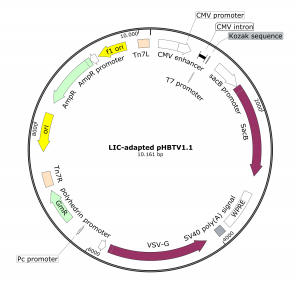For baculovirus-mediated expression in mammalian cells, we require the gene of interest to be present in a BacMam vector. For the expression of single proteins, we use for example the pHBTV1.1 BacMam vector backbone developed by Frederick Boyce from Massachusetts General Hospital, Harvard Medical School in Boston. There are also LIC-adapted versions of the pHBTV1.1 outfitted with different N- and C-terminal tags available from the Structural Genomics Consortium in Oxford. For multi-protein expression, the MultiBacMam system can be used.
As baculoviruses do not replicate in mammalian cells, it’s important to have an effective uptake of the baculoviral particles and efficient transcription of the gene(s) of interest in order to maximize the yields of recombinant protein(s). Pseudo-typing of the BacMam viruses with the Vesicular Stomatitis Virus G protein (VSV-G) has been shown to increase the transduction efficiency. The VSV-G can be incorporated into the viral coat and displayed on the baculoviral surface by including a VSV-G expression cassette either in the BacMam expression vector or in the bacmid DNA used for recombinant baculovirus generation.
The pHBTV1.1 vector contains the VSV-G gene under control of the polH promoter, allowing the production of VSV-G pseudo-typed baculoviruses independent of the bacmid DNA that is used. Furthermore, the pHBTV1.1 vector also includes an optimized hCMV-IE promoter with an intron in the 5’ untranslated region (UTR) and the Woodchuck Hepatitis Virus Posttranscriptional Regulatory Element (WPRE) in the 3’ UTR.
When there’s no VSV-G expression cassette present in the BacMam vector, it’s also possible to introduce the VSV-G protein via the bacmid DNA. For example, the DH10EMBacVSV bacmid backbone includes the VSV-G gene under control of the polH promoter. Additionally, the DH10EMBacVSV genome also contains the mCherry gene under control of the polH promoter, allowing monitoring of the baculovirus production in the insect cells via the mCherry fluorescence.
The MultiBacMam system for multi-protein expression in mammalian cells has a very similar design to the MultiBac system for insect cells. It also consists of 2 acceptor vectors (pACEMam1 and pACEMam2) and 3 donor vectors (pMDC, pMDK and pMDS) that allow flexible and modular combination of individual gene expression cassettes either via Cre-Lox recombination or via the multiplication module. The MultiBacMam vectors carry either the CMV or CAG promoter to drive the protein expression in mammalian cells. More information about the usage of the MultiBacMam system can be found on the website of Geneva Biotech.
References
Fornwald J.A., Lu Q., Boyce F.M. and Ames R.S.(2016) Gene Expression in Mammalian Cells Using BacMam, a Modified Baculovirus System. Methods Mol Biol.1350:95-116.
Barsoum J., Brown R., McKee M. and Boyce F.M. (1997) Efficient transduction of mammalian cells by a recombinant baculovirus having the vesicular stomatitis virus G glycoprotein. Hum Gen Ther. 8(17):2011-8
Bellón-Echeverría I., Carralot J.P., Del Rosario A.A., Kueng S., Mauser H., Schmid G., Thoma R. and Berger I. (2018) MultiBacMam Bimolecular Fluorescence Complementation (BiFC) tool-kit identifies new small-molecule inhibitors of the CDK5-p25 protein-protein interaction (PPI). Sci Rep. 8(1):5083
Mansouri M., Bellon-Echeverria I., Rizk A., Ehsaei Z., Cianciolo Cosentino C., Silva C.S., Xie Y., Boyce F.M., Davis M.W., Neuhauss S.C., Taylor V., Ballmer-Hofer K., Berger I. and Berger P. (2016) Highly efficient baculovirus-mediated multigene delivery in primary cells. Nat Commun. 7:11529
